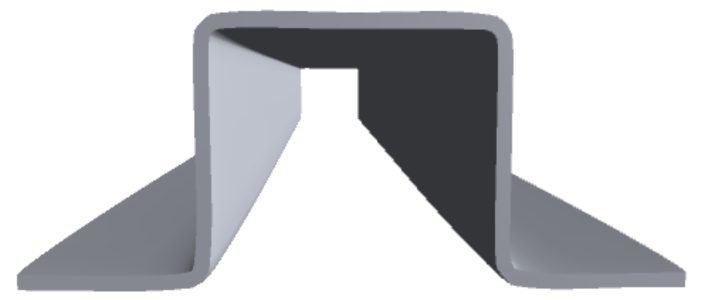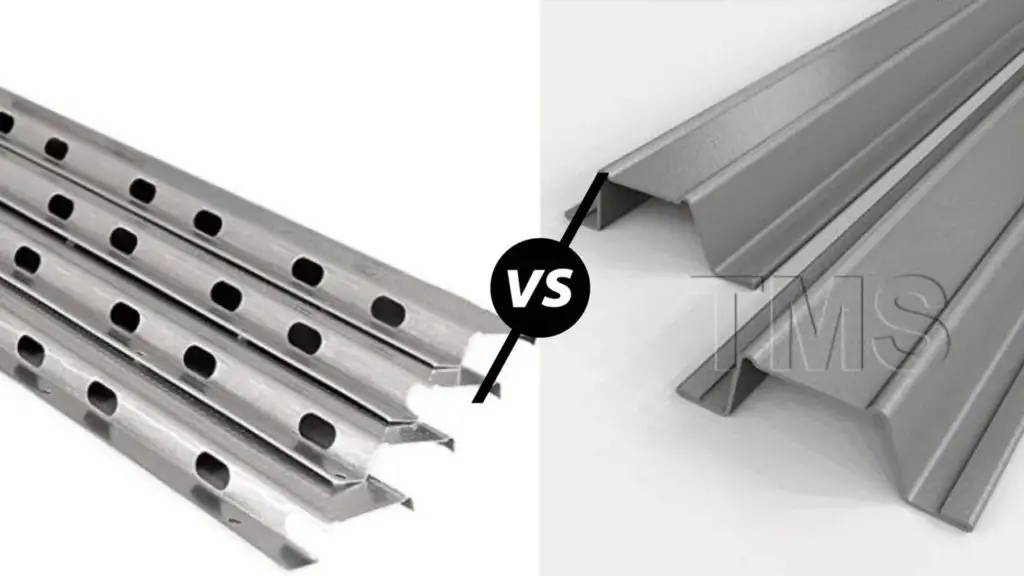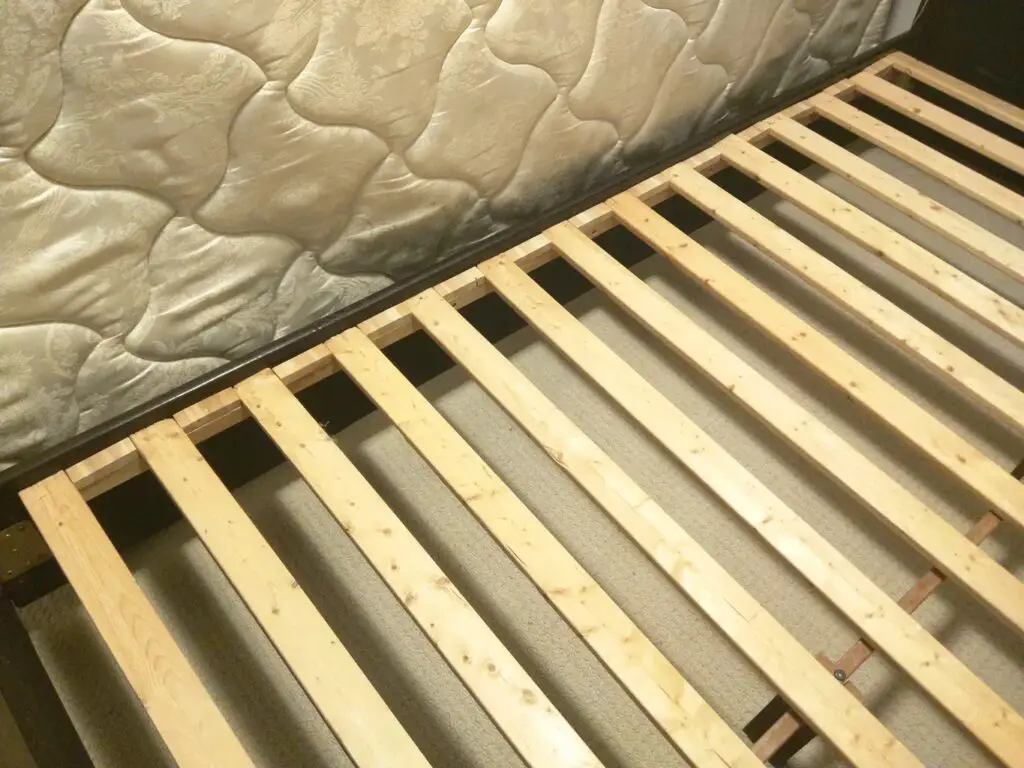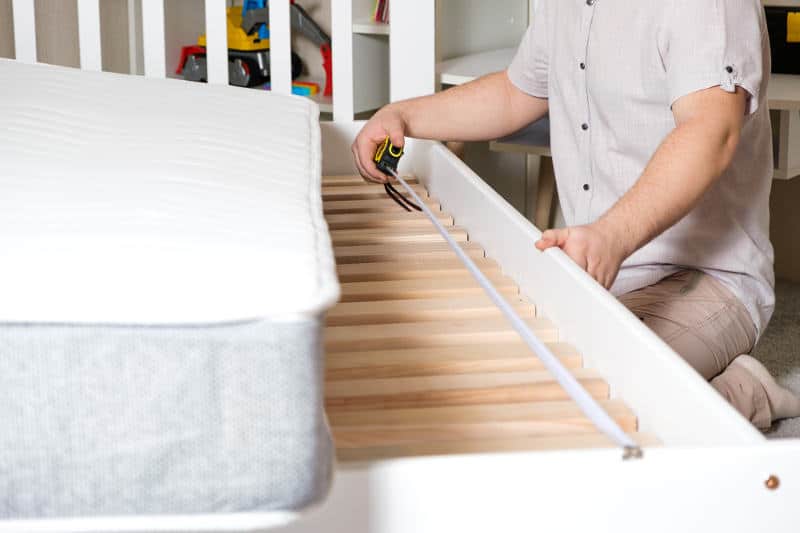In terms of soundproofing substances, resilient channel vs hat channel are both good choices.
Your home’s sound transmission class (STC) is subsequently improved due to its manufacture of concrete or wood.
The hat channel is made of aluminum and galvanized steel, resilient channel is made of holed strip metal.
According to the report, aluminum is a thin, silvery metal.
The sound waves can be easily blocked to an extent of 85% with 15% of the waves still passing through.
Those channels appear to be appropriate for use, but resilient channels build a complex grid network that snares the majority of the noise so that sound waves from it cannot transmit through.
Confused! I am aware that this is the case, so read the entire article where I thoroughly discuss the resilient vs hat channel.
I’ve also explained the usage and any issues you might run into after installing them.
As a result, this will be very interesting and educational because doing so will prevent you from selecting the best option.
So, let’s get started!
Resilient Channel Vs Hat Channel:
Resilient Channel:

These channels are constructed with long-holed strips of galvanized steel.
Similar to a spring channel, it returns to its original shape when you pull it up.
It has two ends, the first is attached to the studs, and the second is drywall, while sound waves do not directly follow their path in this space between the stud and the drywall.
It will become trapped in space and bounce around because the majority of the noise will be eliminated with the aid of this tiny area.
As drywall and insulation are directly connected, soundproofing will not be effective.
However, if you leave the room, it will operate effectively, much like the resilient channel but sound waves also exist in the air surrounding a void that raises mass and airspeed, which raises insulation capacity as well.
Ever hear the phrase “iron cuts iron”? This adage is a perfect fit.
Since this result will be zero if the inside hot or cold air fits with the outside cold or hot air.
Pros:
- It will raise the STC by roughly 10 to 15%.
- Most of the noise will be captured during the acoustic decoupling process.
- The effectiveness of the insulation will rise.
Cons:
- It lacks the typical STC ratings.
How to Set up a Resilient Channel in Your Home?
In reality, installation is very simple but pay attention to line them up and if not, you will need to continually uninstall and reinstall them.
Choose A-Channel:
Resilient channels typically come in one of two varieties: single leg or the first kind, and double leg or the second kind.
Therefore, you must first choose the one you want to install, the only notable difference between the two is that they are identical.
You will receive a second side to appropriately screw them up.
Cut The Right Size:
At this point, all of the channels must be precisely cut to fit your room’s dimensions.
This typically means that you need a larger channel for your larger object.
Align them:
As you install each resilient channel at a time, you must now carefully align them so that they all function properly, otherwise the design might be crooked.
Screw Them:
When you line up them now, you just screw them.
They are not too difficult to lift; simply begin with the center screw, so that it won’t collapse.
Instruction:
- These resilient channels must be aligned with a space of approximately 16 per channel on the center side.
- For better support resilient channel and the hat channel, additional small channels were introduced in the corners.
Hat Channel:

These hat channels are made of a variety of materials including aluminum, commercial-grade steel, and galvanized steel.
The entire structure is more stretchable, so it can easily enlarge and decrease in size in response to seasonal changes.
These channels are designed specifically for solid surfaces that resemble masonry and concrete.
Additionally, these produce air barriers inside the space that act as soundproofing and improve insulation by absorbing outside sound waves.
All you have to do is fasten them perpendicular to the drywall and horizontally to the stud.
Since there are numerous sizes on the market, you can use the size of the channels.
As they’re more accurate and effective at protecting the concrete or masonry ceiling, these channels are typically used on the ceiling.
But as you know, these are made of various materials that need careful observation and superior alternatives because the steel hat channel is challenging to use.
If you want better results, you can mix the two.
Overall effectiveness is increased by 15–20% as a result.
Pros:
- Installing is very simple.
- This produces a smooth surface and is powerful.
- These emit the most radiant fire.
Cons:
- The resilient channel’s impact here is relatively low.
How to set up a Hat Channel in your Home?
Measure the area: The size of the entire room must be measured as the first item that the hat channel will be implanted.
You need to figure out how many channels.
Choose A-Channel: You can choose between hat channels made of steel or aluminum.
Determine the capacity of the substance when you can find both combinations and what challenges will you encounter once they are installed.
Mark a Line: You must draw a straight line on the ceiling after choosing the channel, so that when you arrange them all by the line.
They are not at all bothered by their alignment.
Install Clips: Screws are required for installation in the resilient channels.
But you need clips to install the hat channels that you must securely fasten to the stud.
Fix the channel: When the furring strips have been properly installed.
To finish the process, you must join the hat channels with them.
Instruction:
- Ensure that you adhere to the resilient channel’s exact space instructions to erect a solid building that will muffle noise at any frequency.
- Resilient and hat channels are now familiar terms to you.
- You’ll find it simpler to understand their key differences so that it will be simple for you to select the best one.
Difference between Resilient Channel Vs Hat Channel:

The rear end of resilient channels also known as one-leg resilient hat channels is shorter than the front end which gives a profile akin to a baseball cap.
It has a single leg or brim that is used to attach it to the framing.
A hat channel has a fedora-like profile that requires two screws to attach to studs or joists through each of its legs or brims.
The resilient and hat channels are implanted perpendicular to studs or joists that have a similar installation procedure and price.
Airspace is provided between the insulation and wallboard in RC and hat channel systems that enhance sound control.
An insulated single 5/8-board wall’s STC rating can be increased to 46 using hat channels.
The hat’s dual attachments enable it to support more weight than either the RC-1 or RC-2 channels’ single connections, however, the additional transfer points for sound vibration movement are doubled by the dual connection.
The drywall should be separated from the ceiling, floor, and other boards with a 1/4-inch gap for the best sound absorption.
Acoustic caulk is used to seal the opening to reduce noise seepage, the hat channel’s durability prevents the weight of the gypsum from shifting.
Even so, the system’s weight can start causing the RC system to sag, enabling direct contact with structural members and wiping out any gains.
The RC-1 and 2 systems can improve noise control by an STC of 5 to 10 points in lab tests or under ideal conditions.
The installation of the channels and sheeting contains far too many variables that could allow the sound barrier to be broken.
The passage of flanking noise is also made possible by outlets, switch boxes, ductwork, and doors.
Hat channels are subject to the same problems, excluding sagging.
Less chance of connecting with structural elements exists because the drywall remains in its intended location.
Hat channels can be put in a do-it-yourself, but resilient channels need to be installed by a professional who can offer warranties and guarantees.
How can Resilient Channel Vs Hat Channel Improve Soundproofing?
There are additional methods for sound reduction including resilient channels, sound isolation clips, and hat channels with and without resilient channels.
Air space and adding insulation are two that have already been mentioned, here are three methods that can be added after construction is complete or while renovating.
Double Drywall:
The mass of the wall or ceiling is increased by the second layer of drywall, which also increases the STC valuation up to 10 points.
Acoustic caulking must be used to seal a 1/4′′ gap that must be left all the way around.
Additionally, all structural framing must be avoided when securing the second layer with screws to preserve the sound barrier.
Mass Loaded Vinyl:
Another method to reduce sound vibration is by adding mass-loaded vinyl.
Before fastening the walls or ceiling, the thick polymer sheet can be fastened to studs or joists.
To reduce sound vibration, it can also be hung like a curtain or sandwiched between layers of drywall.
MLV has an STC ranging from 21 to 31 based on its thickness.
Green Glue:
Between layers of drywall, applying a layer of a viscoelastic material will reduce the transfer of vibrations from sound waves by 70% to 90%.
It is simple to use and has good low, medium, and high-frequency sound control.
Challenges With Soundproofing Using Resilient Channel:
- If you don’t have more money to spend on soundproofing your wall or ceiling, resilient channels might be a better choice as these are much less expensive than the hat channel.
- You are completely ignorant of alignment.
- Due to the general hat channels, you only need to attach the clips to finish your task.
- As you are installing the channel, you just screw them. You can’t just put the screw in without finishing the process.
- If not, the procedure must be repeated.
- The better thing you can do is to use a measuring tape and mark an “X” after leaving a gap of 16 inches so that you can raise the resilient channel and easily screw it to the X mark. No need to be overly perplexed.
- Although it takes time, if you follow this process, the risk can be reduced.
- The majority of experts also advise using this procedure.
Also read: Difference between NRC and STC
FAQ- Resilient Channel Vs Hat Channel:
Using bent or extruded metal strips, furring strips are used to attach the small structural component, so that the existing drywall can be attached simply.
You can avoid any short-circuiting with the aid of these strips.
Before measuring the X mark but after installing the channel, all that is required is to simply attach them with the stud.
The hat channel and the furring channel are identical but have different names, so don’t get them mixed up.
It is referred to as a “furring channel” by some professionals and a “hat channel” by the general public.
Resilient channels also function well if you need better soundproofing but don’t want to spend more money.
Although these channels will enhance the air barrier between the stud and the drywall.
To disrupt the direct sound path, it just needs to be carefully installed with better alignment on the surface.
Also read: Pink Noise Vs White Noise
Conclusion:
Both resilient channel and hat channel work well to reduce the noise inside empty spaces, it depends on your need and can afford.
If you have the money, you should use this channel but don’t think that more money is needed to make it more durable and effective at blocking sound waves.
Although it appears to be very difficult hence we have discussed which channel looks great and when you have to choose the best among them.
The sound isolation clips, you must use to install the hat channel are very effective at reducing noise.
Because no movement will cause any vibrations where the resilient channel frequently generates excessive vibrations.
As a result of resilient channels’ inability to maintain the ideal space, however, the hat channel will be simple to maintain due to the assistance you receive from these clips.
Section Under: Diff









